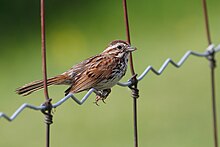Zoomusicology
Zoomusicologists in a wide range of fields including music, semiotics, philosophy and biology conduct zoomusicology research.
Musician and zoomusicologist Hollis Taylor has conducted an extensive study of the Pied Butcherbird (Cracticus nigrogularis) over the past 15 years, including interdisciplinary research with philosophers and scientists.
[5] Composer Emily Doolittle has written numerous pieces based on animal songs, and has published interdisciplinary music-science research on the hermit thrush[6] and the musician wren.
[8][9][10] Susan Belanger has also contributed to the field of zoomusicology, with her work on soft song in the Asian corn borer moth (Ostrinia furnacalis) and its relationship to the initiation of mating behaviour.
Paul Horn played flute to Haida, an orca living at Sealand of the Pacific in Victoria, British Columbia on his album Inside II (1972), though the response was merely spyhopping.
Paul Winter played his saxophone for both wolves (who howled) and gray whales (who did not) on his album Common Ground (1978).
Composer Jim Nollman plays guitar and wooden flute to such species as whales, wolves and turkeys.
Composers have long evoked or imitated animal sounds in compositions, including Antonio Vivaldi's The Four Seasons (Vivaldi) (1720), Jean-Philippe Rameau's The Hen (1728), Camille Saint-Saëns's The Carnival of the Animals (1886), Jean Sibelius's The Swan of Tuonela (1895), Frederick Delius's On Hearing the First Cuckoo in Spring (1912), Ralph Vaughan Williams's The Lark Ascending (Vaughan Williams) (1914), Ottorino Respighi's Pines of Rome (1924) and The Birds (1928), Ferde Grofé's Grand Canyon Suite (1931), Olivier Messiaen's Catalogue of the Birds (1956–58), George Crumb's Vox Balaenae (Voice of the Whale) (1971), and Pauline Oliveros's El Relicario de los Animales (1977).
Field recording expert Bernie Krause in 1988 released a single ("Jungle Shoes"/"Fish Wrap") and an album (Gorillas in the Mix) of songs composed of animal and nature sounds.
[17] In that same year, New York beatboxing artist Ben Mirin began incorporating animal sounds into his beats.
These include, with varying degrees of success, starlings, mockingbirds, thrashers, crows and ravens, parrots, myna birds, blue jays,[21] lyrebirds, Lawrence's thrushes, Acrocephalus, marsh warblers, and others.
[25] During the experiment, a baseline behaviour measurement was established, proceeded by the experimental condition, which was a piece of music that was played for 30 seconds.
Only male humpback whales perform these vocalizations; it was initially hypothesized that these songs may be a part of the sexual selection process.
[26] Although the reason behind this behaviour is uncertain, some have hypothesized that the songs produced by male humpback whales may be a part of escorting, or accompanying females.
One potential barrier in the study of zoomusicology is that there are some forms of music produced by various animals that humans are incapable of hearing.
In the Asian corn borer moth (Ostrinia furnacalis) males produce an ultrasonic soft song to initiate courtship behaviour.
[27] In an unpublished study at the University of Leicester, Liam MacKenzie and Adrian North found that playing music for dairy cows had an effect on the amount of milk that they produced.
[30] The study found the heart rate variability, which indicates a decreased stress level, was significantly higher when the dogs were played reggae and soft rock, but the other three genres had a similar but less pronounced effect.



